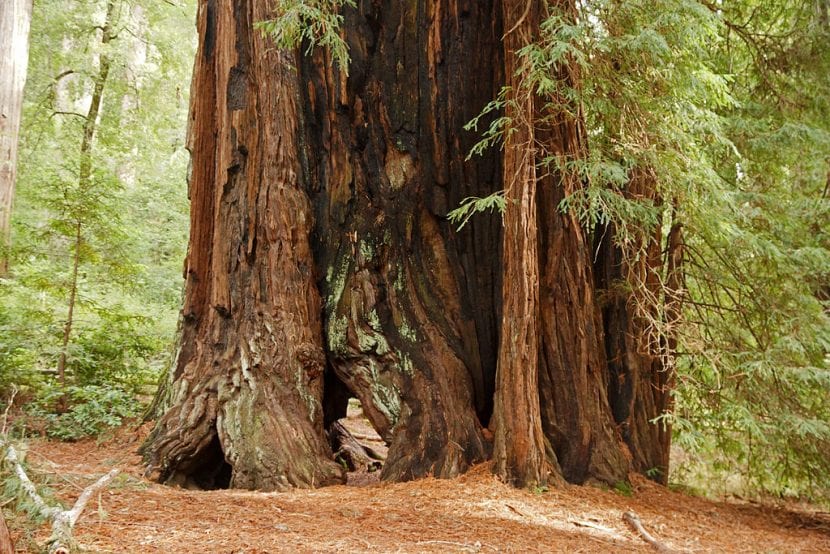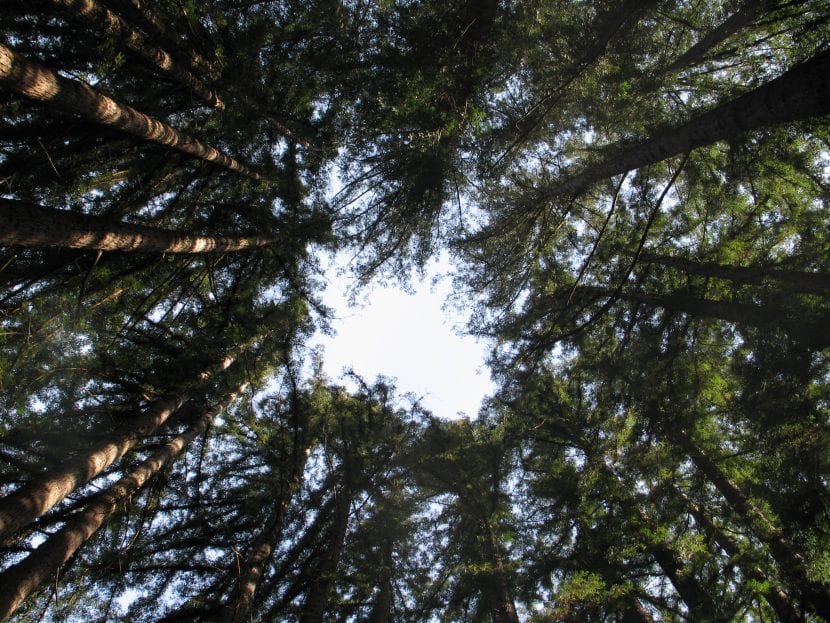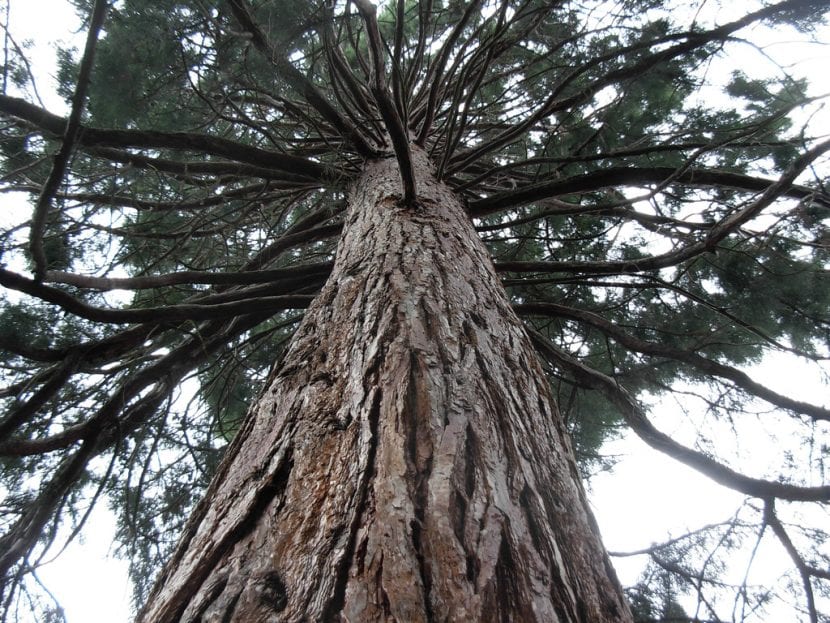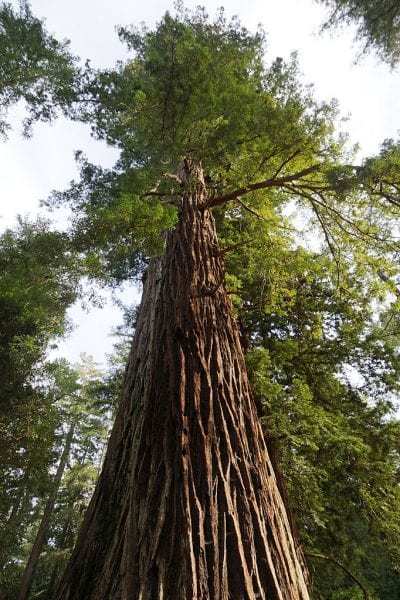
Image - Wikimedia / Everson José de Freitas Pereira
La sequoia sempervirens it can boast of being one of the tallest plants in the world; in fact, a specimen was found that measures neither more nor less than 115,55 meters in height, so it is certainly not an ideal conifer for small gardens, no. But admiring it is wonderful.
Knowing its characteristics, and even its care, will help to better understand this species which is so large that it can occupy a volume of 1203,5 meters.
Origin and characteristics

Image - Wikimedia / Allie_Caulfield
Any human next to him, even those who measure up to two meters, looks very small next to him. And is that if you want to hug the trunk, you need at least thirty people... and yet I would say that there would be a few more missing. This conifer, whose scientific name is sequoia sempervirens, is the only species of the genus (Sequoia), and is known by the names of redwood or California sequoia.
Has a slow growth rate, but it makes up for it with a long life expectancy: at least 600 years, although if the conditions are right it can reach 3200. Its leaves are evergreen; that is to say, they are kept in the plant for several months (perhaps years) before being renewed, and they are green in color, with a size that ranges between 15 and 25mm.
The fruit is an ovoid cone, 15 to 32mm long, with 15-25 scales that are arranged in a spiral. It takes an average of eight months to mature after pollination, which takes place at the end of winter, and contains 3-7 seeds of about 3-4mm long by 0,5mm wide each.
In order to see it grow in its natural state we have to go to the western United States, specifically it lives from Oregon to central California. But also in Europe (in Spain we have in the Cortijo de la Losa, in Puebla de Don Fadrique (Granada), and in Cantabria in what was declared a Natural Monument of the Secuoyas of Monte Cabezón, which occupies an area of 2.467 hectares). In addition, in Mexico they have Las Sequoias Park, in the municipality of Jilotepec.
What are their cares?

Image - Wikimedia / Goldblattster
If you would like to know what this imposing plant needs to grow in good conditions, then we are going to give you a few tips 🙂:
Climate
When you are going to buy a plant it is very important to know if it will live well in our area or not. In the case of redwood, it must be taken into account that it appreciates the temperate climate with weak frosts, humid and with little wind. Therefore, it is a perfect species for mountain gardens or those that are in cool but protected areas.
Location
Of course, it must be abroad. Where exactly? For it to have a good development, the ideal is that it is in semi-shade when young, and that it, as it grows and gains height, is exposed more and more to direct sun.
Earth
It depends on where you are going to have it:
- Flower pot: use growing medium for acidic plants (for sale here) but first add a layer of pumice (on sale here), Or arlite (on sale here).
- Garden: grows in slightly acidic, cool, light and deep soils.
Irrigation
La sequoia sempervirens needs frequent waterings, but avoiding waterlogging at all times. Therefore, so that you do not have problems, it is advisable to check the humidity of the soil before watering, either with a thin wooden stick or with a digital humidity meter.
In the event that you have it in a pot, you will be able to know when it is time if you weigh it once watered and again after a few days, since moist soil weighs slightly more than dry soil 🙂.
Subscriber

Image - Flickr / brewbooks
Fertilizing is just as important as watering. No plant can live solely on water. For this reason, from early spring to late summer must be paid with Organic fertilizers, using liquids if it is kept in a container following the indications specified on the container.
Pruning
You don't need it. Only dry, diseased, weak or broken branches should be removed.
Planting or transplanting time
Whether you want to plant it in the garden or move it to a larger pot -something that by the way you have to do every 2 or 3 years, depending on the growth rate you take- you have to do it in spring, when the risk of frost has passed.
Multiplication
La sequoia sempervirens multiplies by seeds in winter, as it needs to be cold to germinate. The step by step to follow is as follows:
Phase 1 - Stratification
- First, a tupperware with a lid is filled with previously moistened vermiculite.
- Then, sulfur is sprinkled so that the fungi do not proliferate.
- Afterwards, the seeds are added and covered with a little vermiculite.
- Finally, the tupperware is closed and placed in the refrigerator for three months.
Once a week you have to take it out and remove the lid so that the air is renewed.
Phase 2 - Seedling
After the winter, they must be sown in forest trays or in individual pots, putting a maximum of two seeds in each one, with substrate for acidic plants.
It is important to cover them with a very thin layer of substrate since they cannot be exposed, and if they are buried too much or not they will germinate or they will germinate very weakly.
Still, they will germinate throughout the spring.
Rusticity
It resists frosts of up to -10ºC.
What is the largest sequoia in the world?
The tallest redwood belongs to the species sequoia sempervirens, and is located in Redwood National Park, north of San Francisco (California). His name is Hyperion, and measures neither more nor less than 115,55 meters high. But it is not the only one.
In the same park as her there are two more specimens that follow very closely. One is Helios, 114,58 meters high, and the other is Icarus, 113,14m.
What uses is it given?

Image - Wikimedia / Allie_Caulfield
Ornamental
The redwood is a conifer of great ornamental value, perfect for growing in spacious gardens either in lineups or in groups. In addition, it can also be worked as a bonsai.
Wood
Wood, being reddish in color and very resistant, is highly valued for the construction of furniture.
What did you think of sequoia sempervirens?
Where can I get it, leave an address and how much does it cost?